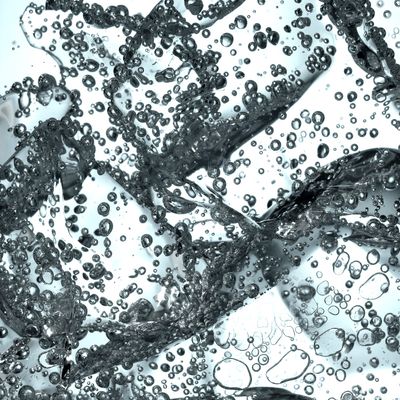
If you haven’t already, chances are good you will see a house-carbonated Negroni at your favorite cocktail joint in the next couple months. Like Newton and Leibniz discovering calculus at the same time, or whoever wrote all those asteroid movies like fifteen years ago, bartenders are simultaneously stumbling across the joys of self-carbonated cocktails.
The drinks aren’t “carbonated” in the traditional sense: In the past, bartenders added a splash of seltzer or Champagne to give their drinks some bubbles. But now, bartenders are adding CO2 directly to drinks, meaning they get the bubbles without the added water that dilutes the drink. “I had no idea anybody else was playing around with it,” Theo Lieberman told me. Lieberman heads up the bar at Lantern’s Keep in midtown Manhattan. “I was in a Williams-Sonoma in the mall and saw one of those iSi Twist ‘n Sparkle things and I just thought it might be cool.”
It is cool — a combination of molecular mixology and simple summer-drink goodness. In fact, house-carbonated drinks first popped up at New York’s wd~50 a few years ago (and, more recently, Manhattan’s Booker & Dax, which opened last January and has an entire section of the house-carbonated drinks); and at Clyde Common in Portland, Oregon, as well as at Grant Achatz’s Aviary bar in Chicago, last year.
But as with a lot of cool things, I also wondered if it wasn’t just a little bit gimmicky, a way of making highfalutin Smirnoff Ice.
Unlike other cocktail fads (mescal a few years ago; Fernet Branca a few months ago; sherry a few days ago), carbonating a drink to order is straight up flashy. Basically bartenders make a drink in the traditional manner, then they put it in a plastic bottle and charge it with CO2, either via a large industrial tank and special airtight bottle caps, or an at-home solution like the Twist ‘n Sparkle. If you’ve never used an iSi Twist ‘n Sparkle before, the experience is like lighting fireworks in a bottle — so much so that iSi recalled the Twist ‘n Sparkle in the U.S. over concerns that the bottles might explode.
The first time I personally saw a house-carbonated drink on a menu was at Harry Denton’s Starlight Room in San Francisco, with Joel Teitelbaum, the bar manager there. Teitelbaum serves a few house-carbonated drinks (and presents them in tiny soda bottles), including a Negroni, a mojito, and a gin and tonic. The gin and tonic seems like one drink that specifically does not need the carbonation treatment, but Teitelbaum does it anyway: He mixes homemade tonic syrup with gin and distilled lime juice and then fires the whole thing up with CO2. “It does feel a little gimmicky on the surface,” he admitted, before adding, “The whole molecular mixology thing gets a bad rap because it can be used as a sideshow — covering up something inherently uninteresting instead of improving it.” It seemed to me that gussied-up mojitos and G&Ts; were exactly that, needless recreations made simply to show off. But when I tried it, I realized I was wrong: The house-carbonated version was better integrated than other G&Ts; I’d had. It was light and lime-y and it reminded me almost of a fresh-made daiquiri.
According to Teitelbaum, classic cocktails are the perfect drinks to carbonate because they take something familiar and skew them through the sensibility of a real-deal cocktail enthusiast and pro. Think of them as gateway drinks. Teitelbaum says classic cocktail culture’s rise to national awareness has paradoxically created a more intimidating scene for those who haven’t yet jumped in. Whereas a lay-drinker could once order a vodka soda or a Lemon Drop unapologetically, they have now gotten the message that they should know better. So they hem and haw because they don’t want to sound like that kid who brings up Green Day in a conversation about Fugazi, and they just go for a gin and tonic.
Teitelbaum’s staff gets curious looks when they hand over the pre-bottled gin and tonic. He says customers usually ask “if we order our gin and tonics premade from some dumb company like Club.” The reason the staff goes through all this trouble is because it forces the habitual gin-and-tonic drinker to think about what they’re drinking. “As bartenders, we want them to ask questions,” Teitelbaum says. Normally, “gin-and-tonic drinkers never ask questions.”
Of course, there are reasons to carbonate beyond education. When you make a gin and tonic in the normal way — pour tonic water on top of gin and ice — some science-y stuff happens that causes the drink to dilute pretty quickly, even if you have one of those huge ice cubes. That’s why gin and tonics always taste like watered down gin and tonics when you’re halfway through. By mixing the drink’s component parts and then carbonating the whole mix without ice, you can manage the dilution super-precisely. (Same goes for a Negroni, though you notice the dilution less because Campari is like the Andre the Giant of flavors.)
But more importantly, these drinks just straight up work. Carbonation makes seriously heavy drinks — like a Negroni, or even a Sazerac — more appropriate for poolside sipping. (Oh man, I love the idea of someone sipping a Sazerac by the pool.) “Carbonation is like the modern equivalent of egg white,” Teitelbaum told me. “It changes the texture without changing the base flavor.” Like Thurston Moore putting out a folk album, a carbonated Negroni is just as hardcore as ever, while simultaneously feeling slightly more graceful.
Matthew Latkiewicz writes about drinking and other subjects at You Will Not Believe. His work has appeared in McSweeney’s, Wired, Time.com, Boing Boing, and Gastronomica. Follow him on Twitter.




